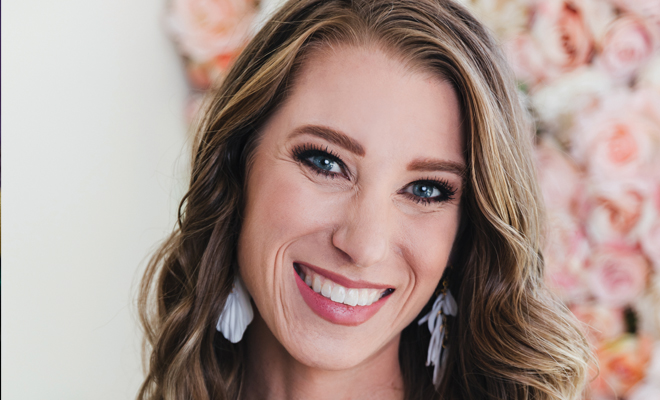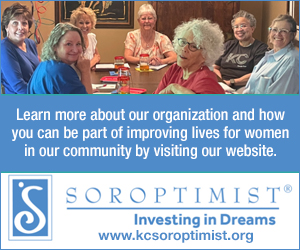 Amber J Deery
Amber J Deery
Katherine Blauwiekel: “Creating is healing from the inside out.”
Therapists have long known that employing the creative arts, such as dance, theater, writing, artwork and such, can be a key tool in reducing anxiety and depression, coping with past trauma and otherwise building positive mental health. Creative-arts therapy can be one of hundreds of tools that therapists use to treat their clients. But participating in creative projects on your own can move you to discover purpose, comprehend emotions and better connect with others. It’s accepted by the mental health community that simply producing art can have a therapeutic impact.
Katherine Blauwiekel appreciates the power of creative arts in the healing process. The owner of Anne-Marie Designs, based in Olathe, Kansas, is a wedding bridal and everyday luxury jewelry designer with a focus on crafting custom pieces. Her company moniker comes from a mixture of names honoring her daughter and her mother and grandmothers, strong women with an eye for creating beautiful crafts and artwork. In just a short time, Katherine’s become the darling of the international fashion scene with her individual pieces and jewelry sets in clay, in which colors and shapes unite in exquisite patterns that seize the eye.
She’s been singled out by fashion and design magazines across the globe. Harper’s Bazaar writes, “Jewelry designer Katherine Blauwiekel is making waves as one of the newest designers on the market. It is no surprise jewelry lovers across the globe are enamored by the artistry and romanticism each piece in her collection conveys.” Vanity Fair reports, “Anne-Marie Designs is a highly coveted Kansas-based brand adored across the globe for the artistry and romanticism their luxury collection conveys. Crafted with a mixture of gold accents, Swarovski crystals and freshwater pearls, there is no doubt you will be set to walk down the red carpet in any piece from this collection.” Vogue, House and Garden and even U.K.-based Tatler splash her pieces across glorious fashion layouts and boast her success.
Driven to Create
Katherine shares that she has always felt the need to create, beginning with crafting projects as a child, but her move into producing her jewelry came at a time when she was desperate for relief. She began crafting as a way to break through the mental anguish she was experiencing. This wife and new mother had no idea that her earrings, bracelets, hair accessories and more would grow into the international sensation that it is today.
“I didn’t intend this to be a business. It was a way to get out of my head, to be a good mom and to be healthy for me. I found a way to do something that brings me great joy,” remarked Katherine. “I have a lot of dreams for this business going beyond jewelry. But doing this has changed my life for the better. It’s helped mentally and emotionally in all aspects.”
Katherine shares that throughout her life she has experienced several traumatic encounters and events that left deep marks on her inner self, and she struggled to find ways to cope. Her issues came to a head after the traumatic events of undergoing an emergency delivery with her daughter in order to save her life. Then, she found herself struggling with post-partum depression and anxiety. It was then that she delved into her creative side to find a way to escape from the pain.
Although she didn’t realize it at the time, she was using creative arts to externalize her negative experiences and put them in a different place rather than keeping it internal. Creative arts use a lot of our right brain while also calling on the left side of our brain as we organize and track our actions to create the final piece. Katherine relates from her own experiences that trauma has an effect on both brain and body due to the intense fear associated with it. Any time individuals are “alone with fear,” that’s bad, and employing creative arts can help bring out that fear. If someone is dealing with trauma, having a mental health professional assist while one creates is incredibly helpful.
For Katherine, creating her jewelry gave her a way to better understand her emotions and visualize an optimistic future. At that time, she wasn’t aware of scientific studies that prove creative art therapies can improve mood and even lower stress hormones. But now Katherine is so convinced of the power of healing through creative arts that she dreams of establishing a nonprofit organization to help others, from children to the elderly, to employ the healing goodness of creative arts.
“I want to build a foundation to teach people about art therapy. You don’t have to talk about past traumas to heal and you don’t have to be creative. You use hands and think and process so much emotionally that you don’t realize you’re healing from the inside out,” said Katherine. “It’s so important for people who are struggling, and some people can’t talk about their trauma, but you can heal without having to voice your trauma. It releases this weight on your whole life. I want to give that option to others and that you’re not stuck in this dark place but you can heal.”
Fashioning Wearable Works of Art
When you see the awe-inspiring creations Katherine offers at Anne-Marie Designs, you understand how using her hands and mind to design helped her deal with adversity. These exquisite, wearable works of art will leave you wondering how it could be clay. From floral to bridal, each piece embraces originality and romanticism. The Anne-Marie collection is created in Katherine’s home studio using a foundation of clay, highlighted with gems, precious metals, pearls and crystals to fashion offerings for customers across the globe. Her gorgeous “glass” technique turns clay into a translucent beauty.
“I’m known for my elaborate floral pieces. Everything I make is unique because I literally create with how I’m feeling that day. I’m not making something because I think it will sell; I’m making it because of an event that’s happened. I’m making it because of how I’m feeling,” noted Katherine. “If I’m having a bad day, I will create. Some of my most amazing pieces I’ve made have come from a sad event. But I can look at this cool piece and say that there is beauty in the darkness. It’s healing to me on so many different levels.”
Her pieces fall into various lines including Bridal, Floral, Glass and Everyday. In Everyday, you’ll find floral, glass, studio scraps and solid designs, all one-of-a-kind-creations, sold online or through carefully selected retailers.
The success of Anne-Marie Designs is something that all entrepreneurs dream of experiencing. But Katherine offers that knowing yourself and allowing that expression to drive your strategy is the best advice she can give for others. “Always do it for yourself. The second that you get into the mindset of ‘I think this will sell or this will make more money,’ you’ll burn yourself out, you’ll lose your passion and you’ll lose your creativity because you’ve lost yourself in the money,” Katherine advised. “If you stay true to who you are and what you love, the creativity and passion will keep coming. If you’re doing your business for ‘me,’ the followers and money will come. I work 5 to 5 every single day, but I still wake up ready to go.”
Her Family Tradition
It seems that Katherine and Anne-Marie Designs have become a global overnight sensation. But her success was decades in the making, planted and nurtured by the crafting passion of her strong and gifted female family members, who provided a roadmap for her own passions. “I want people to feel hopeful. I want them to see my story and think that they too could do this. It may not be the same realm but they should know that they don’t have to have a doctorate degree to follow a passion. I want them to be inspired to do what they love and not fit in a job they’re miserable at. They can find something that they love and find happiness because this world is very sad right now, but there are things that you can do to be happy.”
But her key message focuses on the ability to call upon a person’s individual strength and find a way to heal. “Don’t feel alone. People look at me and see the success but they don’t know the pain and trauma I’ve been through in my life to get me to the headspace that I’m in today,” Katherine commented. “People don’t talk about mental health or the trauma they’ve been through. So many people are suffering silently. I want to step up and be a voice and tell them you’re not alone. There’s always a light at the end of the tunnel; you just have to choose the right path.” ■
DESIGNING NEW STRATEGIES
Katherine relates that her mental health struggles moved her to employ Eye Movement Desensitization and Reprocessing or EMDR. This psychotherapy approach helps people heal from trauma or hardships and has been used extensively in military veterans returning from combat. However, any individual can experience a level of healing with EMDR, including those who have issues of abuse, bullying, domestic violence, grief/loss, attachment wounds, abandonment, PTSD and many other life issues. It can help people with addictions, anxiety, eating disorders and more. Although it’s a fairly new therapy, developed in 1989, it has been validated by some two dozen randomized, controlled clinical trials.
Instead of talk therapy or medications, EMDR uses a different method to help therapists address psychological issues with their clients. Through EMDR, a patient’s own rapid, cadenced eye movement is called upon to treat symptoms, diminishing the influence of the past traumatic event. Some therapists use finger movements, hand or toe tapping or musical tones to displace the negative emotions. In Katherine’s case, her therapist employs a handheld stimulator along with a lighting device that she follows with her eyes. She talks about the trauma and recalls the emotions and sensations experienced. Gradually, the discussion shifts to more pleasant thoughts. The goal is that eventually the brain replaces the hurtful memories with positive thoughts, which weakens the effect of the negative emotions on the body and mind. Basically, the brain is trained to replace the negative thought with an acceptable one.









